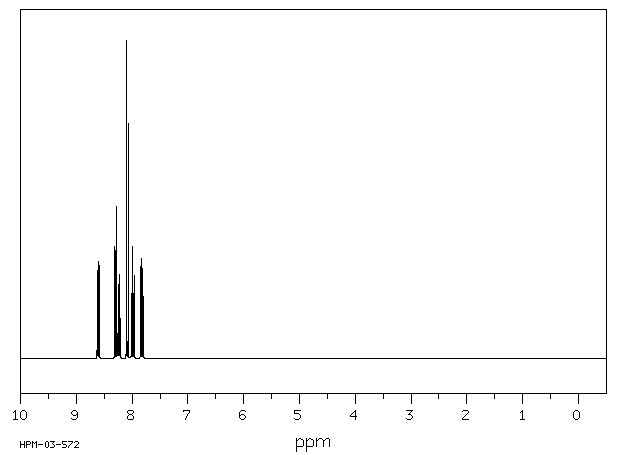tetrazolo[1,5-a]quinoline | 235-25-6
中文名称
——
中文别名
——
英文名称
tetrazolo[1,5-a]quinoline
英文别名
tetrazolo<1,5-a>quinoline;Tetrazolo<1,5-a>chinolin;tetrazolo[1,5-a]quinoline;Tetrazolo[1,5-a]chinolin;Tetrazolo<1,5-a>quinolin;Tetrazolo<1.5-a>chinolin
CAS
235-25-6
化学式
C9H6N4
mdl
MFCD00046874
分子量
170.173
InChiKey
HHFCAUSIBNOUOP-UHFFFAOYSA-N
BEILSTEIN
——
EINECS
——
-
物化性质
-
计算性质
-
ADMET
-
安全信息
-
SDS
-
制备方法与用途
-
上下游信息
-
文献信息
-
表征谱图
-
同类化合物
-
相关功能分类
-
相关结构分类
计算性质
-
辛醇/水分配系数(LogP):1.6
-
重原子数:13
-
可旋转键数:0
-
环数:3.0
-
sp3杂化的碳原子比例:0.0
-
拓扑面积:43.1
-
氢给体数:0
-
氢受体数:3
SDS
反应信息
-
作为反应物:描述:tetrazolo[1,5-a]quinoline 以 氯苯 、 苯 为溶剂, 反应 38.0h, 生成 2-Chinol-2-yl-1,3-bis(chinol-2-ylimino)-1,3,5-triazino<1,2-a>chinolin参考文献:名称:Boedeker, J.; Courault, K.; Koeckritz, A., Journal fur praktische Chemie (Leipzig 1954), 1983, vol. 325, # 3, p. 463 - 474摘要:DOI:
-
作为产物:描述:N-(2-ethynylphenyl)formamide 在 sodium azide 、 N,N-二异丙基乙胺 、 三氯氧磷 作用下, 以 二氯甲烷 、 N,N-二甲基甲酰胺 为溶剂, 反应 2.0h, 生成 tetrazolo[1,5-a]quinoline参考文献:名称:叠氮基引发的邻炔基异氰基苯的双环化反应:替他唑洛[1,5-a]喹啉的合成摘要:描述了邻炔基异氰基苯与叠氮化钠反应的四唑并[1,5- a ]喹啉的有效合成方法。该反应通过将叠氮化物亲核加成到异氰化物中,然后进行6-内环化来进行。DOI:10.1002/ejoc.201901209
文献信息
-
Reaction of N-fluoropyridinium fluoride with isonitriles and TMSN3: a convenient one-pot synthesis of tetrazol-5-yl pyridines作者:Alexander S. KiselyovDOI:10.1016/j.tetlet.2005.05.066日期:2005.7Reaction of N-fluoropyridinium fluoride generated in situ with a series of isonitriles and TMSN3 led to the formation of the corresponding tetrazol-5-yl pyridines in good yields (37–84%). A similar reaction sequence for quinoline yielded the respective derivatives of 2-quinoline. The proposed reaction mechanism involves the intermediate formation of a highly reactive carbene species.
-
Regioselective Chlorination of Quinoline<i>N</i>-Oxides and Isoquinoline<i>N</i>-Oxides Using PPh<sub>3</sub>/Cl<sub>3</sub>CCN作者:Kai Qiao、Li Wan、Xiaoning Sun、Kai Zhang、Ning Zhu、Xin Li、Kai GuoDOI:10.1002/ejoc.201501567日期:2016.3A novel method for the regioselective C2-chlorination of heterocyclic N-oxides has been developed. PPh3/Cl3CCN were used as chlorinating reagents and the desired N-heterocyclic chlorides were obtained smoothly in satisfactory yields. The reactions proceeded in a highly efficient and selective manner across a broad range of substrates demonstrating excellent functional group tolerance. In addition,
-
TRICYCLIC INHIBITORS OF 5-LIPOXYGENASE申请人:Hutchinson John Howard公开号:US20070173508A1公开(公告)日:2007-07-26Described herein are compounds and pharmaceutical compositions containing such compounds, which inhibit the activity of 5-lipoxygenase (5-LO). Also described herein are methods of using such 5-LO inhibitors, alone and in combination with other compounds, for treating respiratory, cardiovascular, and other leukotriene-dependent or leukotriene mediated conditions, diseases, or disorders.
-
Fused Tetrazoles as Azide Surrogates in Click Reaction: Efficient Synthesis of N-Heterocycle-Substituted 1,2,3-Triazoles作者:Buddhadeb Chattopadhyay、Claudia I. Rivera Vera、Stepan Chuprakov、Vladimir GevorgyanDOI:10.1021/ol100745d日期:2010.5.7It has been shown that various pyrido-, quinolino-, pyrazino-, and quinoxalinotetrazoles can be used efficiently as azide components in Cu-catalyzed click reaction with alkynes. This method allows for efficient synthesis of a wide variety of N-heterocyclic derivatives of 1,2,3-triazoles.
-
Luminescence Modulations of Rhenium Tricarbonyl Complexes Induced by Structural Variations作者:Hélène C. Bertrand、Sylvain Clède、Régis Guillot、François Lambert、Clotilde PolicarDOI:10.1021/ic5007007日期:2014.6.16metal–carbonyl complexes SCoMPIs for single-core multimodal probes for imaging. Re(I) tricarbonyl complexes have unique photophysical properties allowing for their unequivocal detection in cells but also present some weaknesses such as a very low luminescence quantum yield in aqueous medium. Further optimizations would thus be desirable. We therefore developed new Re(I) tricarbonyl complexes prepared from八面体d 6低旋转Re(I)三羰基络合物作为无创成像探针备受关注,并且由于其生物稳定性,低毒性,大的斯托克斯位移和长的发光寿命而受到了深入的研究。我们最近报道了细胞中带有Pyta配体(4-(2-吡啶基)-1,2,3-三唑)的Re(I)三羰基配合物的双峰红外和发光成像,并标记了此类金属-羰基配合物SCoMPIs单核的多模态成像探头。Re(I)三羰基配合物具有独特的光物理特性,可以在细胞中进行明确检测,但也存在一些缺点,例如在水性介质中的发光量子产率非常低。因此,将需要进一步的优化。因此,我们开发了由不同的辅助配体制备的新的Re(I)三羰基配合物。具有苯并噻二唑-三唑配体的配合物在乙腈中显示出有趣的发光量子产率,并且可能在有机介质中构成有价值的发光金属配合物。具有双齿的1-(2-喹啉基)-1,2,3-三唑(Taquin)和1-(2-吡啶基)-1,2,3-三唑(Tapy)配体的一系列配合物,带有
表征谱图
-
氢谱1HNMR
-
质谱MS
-
碳谱13CNMR
-
红外IR
-
拉曼Raman
-
峰位数据
-
峰位匹配
-
表征信息
同类化合物
(S)-4-(叔丁基)-2-(喹啉-2-基)-4,5-二氢噁唑
(SP-4-1)-二氯双(喹啉)-钯
(E)-2-氰基-3-[5-(2,5-二氯苯基)呋喃-2-基]-N-喹啉-8-基丙-2-烯酰胺
(8α,9S)-(+)-9-氨基-七氢呋喃-6''-醇,值90%
(6,7-二甲氧基-4-(3,4,5-三甲氧基苯基)喹啉)
(1-羟基-5-硝基-8-氧代-8,8-dihydroquinolinium)
黄尿酸 8-甲基醚
麻保沙星EP杂质D
麻保沙星EP杂质B
麻保沙星EP杂质A
麦角腈甲磺酸盐
麦角腈
麦角灵
麦皮星酮
麦特氧特
高铁试剂
高氯酸3-苯基[1,3]噻唑并[3,2-f]5-氮杂菲-4-正离子
马波沙星EP杂质F
马波沙星
马来酸茚达特罗杂质
马来酸茚达特罗
马来酸维吖啶
马来酸来那替尼
马来酸四甲基铵
香草木宁碱
颜料红R-122
颜料红210
颜料红
顺式-苯并(f)喹啉-7,8-二醇-9,10-环氧化物
顺式-(alphaR)-N-(4-氯苯基)-4-(6-氟-4-喹啉基)-alpha-甲基环己烷乙酰胺
非那沙星
非那沙星
青花椒碱
青色素863
雷西莫特
隐花青
阿莫地喹-d10
阿莫地喹
阿莫吡喹N-氧化物
阿美帕利
阿米诺喹
阿立哌唑溴代杂质
阿立哌唑杂质B
阿立哌唑杂质38
阿立哌唑杂质1750
阿立哌唑杂质13
阿立哌唑杂质
阿立哌唑杂质
阿尔马尔
阿加曲班杂质43







